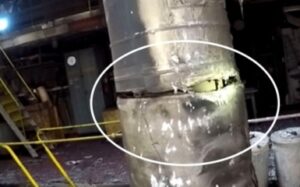
The Transportation Safety Board of Canada (TSB) has published its investigation report into the engine room fire onboard the bulk carrier Cuyahoga that occurred in May 2023. The Cuyahoga was loaded with granular crushed stone as she left Marblehead, Ohio, U.S., bound for Kingsville, Ontario on Lake Erie. Almost three hours into the voyage, a fire ignited in the engine room. The crew initiated an emergency response, cut the fuel supply to the main engine, and attempted to activate the CO2 fixed fire suppression system remotely, without success. An attempt to locally activate the fixed fire suppression system also failed and resulted in the cylinder room flooding with CO2. Due to the cessation of fuel flow, the engine stopped, and the fire extinguished itself soon after.
Findings as to causes and contributing factors in the Cuyahoga incident
These are the factors that were found to have caused or contributed to the occurrence.
- The retaining clamps on the fuel injection lines were not in place, increasing the fuel lines’ exposure to the effects of engine vibration.
- Rectifying the fuel injection line leaks was incorporated into routine maintenance tasks. Consequently, there was no evaluation of the cause of the repeated leaks.
- Without accurate, documented procedures available to them, crew members developed their own practices for managing fuel injection line leaks; this led to fittings not being adequately tightened to resist the vibration-loosening process. As a result, these deviations from the manufacturer’s instructions likely contributed to the loosening of the fittings.
- A fitting on a fuel injection return line loosened and disconnected, creating a fuel spray.
- Gaps in the insulation exposed hot surfaces on the exhaust gas piping at the turbocharger outlet, and the fuel spray ignited on contact with those surfaces.
- The remote release cables for the fixed fire suppression system were located in an exposed location in the engine room and were damaged by the fire. Consequently, the cables failed and carbon dioxide (CO2) was not discharged into the engine room, requiring a crew member to attempt a local release.
- Unknown to the crew, an isolation valve in the fire main piping was corroded and it obstructed the flow of water to the fire.
Findings as to risk
These are the factors in the Cuyahoga occurrence that were found to pose a risk to the transportation system. These factors may or may not have been causal or contributing to the occurrence but could pose a risk in the future.
- If personnel carrying out maintenance work do not have the most current documentation issued by equipment manufacturers, safety updates and corrections will not be available for use. Consequently, poor equipment performance and breakdowns are more likely to occur, increasing the risk to the crew and to the vessel.
- If ventilation points and other openings to a compartment on fire cannot be accessed and closed, there is a risk that efforts to control and extinguish the fire will be delayed or unsuccessful. When individuals involved in inspection and maintenance of fixed fire suppression systems are unaware of the manufacturer’s instructions, deficiencies may not be identified and corrected, increasing the risk that these systems will fail in the event of a fire.
- If instructions for the operation of CO2 fixed fire suppression systems are not clear, detailed, and specific to the installation, there is a risk that such systems will not be successfully and safely operated in an emergency.
- Realistic scenarios describe events that are likely to occur in an emergency, such as a missing crew member during an engine room fire. If such scenarios are not used for emergency drills, a crew will be less prepared to make rapid decisions, assess the results, and adjust actions accordingly.
- If vessel-specific instructions for fire response are missing or inadequate, there is a risk that the crew will be unable to respond effectively to a shipboard fire.
- If only the minimum required quantities of firefighting equipment are carried on board, then any response beyond activities such as monitoring and boundary cooling is likely to increase the risk to the crew.
- If crew only have access to the minimum quantity of firefighting equipment required by regulations, then they will be unable to safely use the firefighting knowledge and skills taught in Marine Emergency Duties training. Consequently, vessel firefighting and containment activities will be limited and risks to the crew increased.
Other findings
These findings resolve an issue of controversy, identify a mitigating circumstance, or acknowledge a noteworthy element of the occurrence.
- Following an earlier fire on board another Lower Lakes Towing Ltd. vessel, instructions at the Cuyahoga’s remote CO2 release station were revised to give accurate information about how to confirm that a release was successful and describe post-release safety precautions.
- Certain regulations to mitigate fire risks did not apply to the Cuyahoga due to age-related exemptions.
- Although the CO2 fixed fire suppression system was not discharged, the ventilation through the skylight likely helped stop the fire from spreading, and the engine shutting
Safety action
During the repairs to the carbon dioxide (CO2) fixed fire suppression system, the remote cables between the engine room access door and the cylinder compartment were routed outside of the engine room along the deck and skylight on the boat deck. The instructions for operating the CO2 system controls were modified, directing the crew to operate the directional stop valve before operating the control heads on the cylinders.
Download the pdf report: TSB report on Cuyahoga